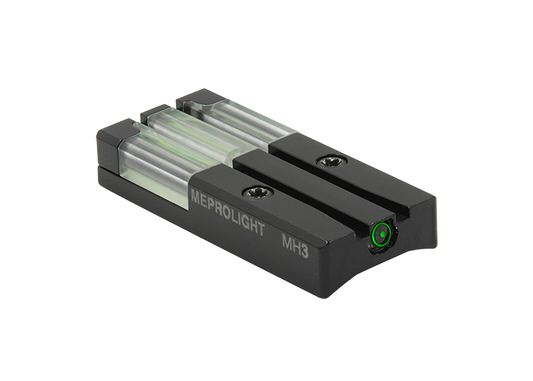

Meprolight FT Bullseye Sight for IWI Jericho offers precision targeting with its innovative combination of fiber-optic and tritium technologies. This sight enhances visibility in various lighting conditions, ensuring quick target acquisition during the day and at night. Its compact and low-profile design allows for easy installation on existing pistol dovetails, making it a practical choice for both beginners and experienced shooters. The sight’s intuitive aiming system, featuring a self-illuminated dot and circle bullseye, simplifies aiming and improves shooting accuracy.
Designed to operate without batteries, the FT Bullseye Sight utilizes fiber optics for daylight visibility and premium-grade tritium for low-light conditions, providing a reliable solution for tactical shooting and competition. This lightweight sight is compatible with most holsters, ensuring versatility in your shooting setup. With a guaranteed tritium lifespan of 12 years, this sight maintains consistent performance, enhancing your shooting experience across all scenarios.
Key Features:
- MAXIMUM BRIGHTNESS: Swiss-made Tritium vials deliver unparalleled brightness, ensuring visibility in low-light and nighttime conditions. No batteries or external light sources required.
- LOW PROFILE DESIGN: The MEPRO FT Bullseye is a single rear sight that aligns the point of aim using a self-illuminated dot and circle bullseye. No front sight needed.
- ALWAYS ON, ALWAYS READY: Powered by fiber optics for daylight shooting and premium-grade tritium for nighttime use, the MEPRO FT Bullseye remains constantly illuminated, providing instant target acquisition.
- SMALLEST OPTICAL SIGHT: Based on a patented optical illumination, this sight is the smallest in the world, offering superior visibility in all lighting conditions.
- FITS MOST HOLSTERS: With its compact design and easy installation on existing pistol dovetails, the MEPRO FT Bullseye is compatible with a wide range of holsters.
- SIMPLE INSTALLATION: Effortlessly install the MEPRO FT Bullseye on your pistol dovetail for quick and easy setup.
- NO BATTERIES - NO SWITCHES: Enjoy the convenience of a sight that is always on and ready for action. No need to worry about battery life or manual activation.
- NIGHTTIME ILLUMINATION GUARANTEED: The MEPRO FT Bullseye's tritium illumination is guaranteed to last for 12 years, providing reliable performance over an extended period.
Technical Specifications
| Color: | Black/Clear |
| Fabric/Material: | Metal / Tritium |
| Front Material: | Tritium |
| Gun Type: | Pistol |
| Gun Make: | Jericho |
| Illumination Type: | Tritium |
| Condition: | New |
What's in the Box?
- Meprolight FT Bullseye Sight
- Installation Manual
Customer Reviews
"The Meprolight FT Bullseye sight is incredibly intuitive. I found target acquisition to be faster than ever, even in low light." - Alex R.
"Installation was straightforward, and the sight fits perfectly on my Jericho. Highly recommend for anyone looking for reliable performance." - Jamie K.
"This sight has transformed my shooting experience. The tritium illumination works flawlessly at night." - Chris T.
FAQ
How does the Meprolight FT Bullseye perform in low-light conditions? The sight features premium-grade tritium that ensures visibility in low-light environments, providing a consistently illuminated aiming point for quick target acquisition.
What type of maintenance does the sight require? The Meprolight FT Bullseye requires minimal maintenance. Regularly check for dirt or debris on the lens and ensure the sight is securely mounted. No battery replacements are needed, making upkeep simple.
Can I use the FT Bullseye on other pistol models? This sight is specifically designed for IWI Jericho models but may fit other pistols with compatible dovetail mounts. It's advisable to check the specifications of your firearm before purchasing.
How does this sight compare to traditional sights? Unlike traditional sights, the Meprolight FT Bullseye uses a combination of fiber optics and tritium for all-day visibility without the need for batteries, making it more reliable in varied lighting conditions.
Is the installation process complicated? Not at all. The installation is user-friendly and designed for quick setup on existing pistol dovetails, allowing for hassle-free mounting.
Similar Models
Looking for the perfect tactical sight? Explore our extensive Meprolight collection, including models like Meprolight RDS for enhanced reflex shooting and Meprolight M21 for versatile day-night performance. Discover our complete range of optics tailored to your shooting needs.
You May Also Like
Here’s some of our most similar products people are buying. Click to discover trending style.









